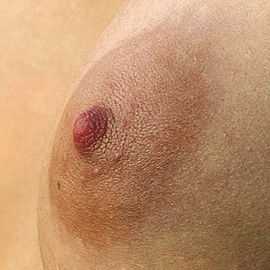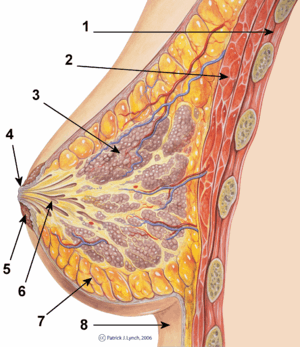Areola
| Areola | |
|---|---|
 Close-up of a human female breast showing the areola | |
 Breast schematic diagram (adult female human cross section) Legend: 1. Chest wall 2. Pectoralis muscles 3. Lobules 4. Nipple 5. Areola 6. Duct 7. Fatty tissue 8. Skin | |
| Details | |
| Latin | areola mammae |
| Identifiers | |
| Gray's | p.1267 |
| TA | A16.0.02.012 |
| FMA | 67796 |
| Anatomical terminology | |
In anatomy, an areola (/əˈriːələ/[1][2] or /ɛriːˈoʊlə/[2]) is any small circular area on the body coloured differently from the surrounding tissue. The term is most commonly used to describe the pigmented area on the human breast around the nipple (areola mammae) but it can also be used to describe other small circular areas such as the inflamed region surrounding a pimple.
The plural of "areola", is "areolæ"/"areolae", which is pronounced /əˈriːəliː/ or /əˈriːəlaɪ/. "Areola" is the diminutive of Latin area, "open place".
Human mammary areola
Careful inspection of a mature human female nipple will reveal several small openings arranged radially around the tip of the nipple (lactiferous ducts) from which milk is released during lactation. Other small openings in the areola are sebaceous glands, known as Montgomery's glands (or glands of Montgomery).[3] These can be quite obvious and raised above the surface of the areola, giving the appearance of "goose-flesh".
Color
The areola can range from pink to red to dark brown or nearly black, but generally tend to be paler among people with lighter skin tones and darker among people with darker skin tones. It has been suggested that a reason for the differing color is to make the nipple area more visible to the infant.[4]
Size and shape
The size and shape of areolae are also highly variable, with those of sexually mature women usually being larger than those of men and prepubescent girls. Human areolae are mostly circular in shape, but many women and some men have areolae that are noticeably elliptical.
The average diameter of male areolae is around 25 mm (1 in). Sexually mature women have an average of 38.1 mm (1.5 in), but sizes range up to 100 mm (4 in) or greater.[5] Lactating women, or women with particularly large breasts, may have even larger areolæ. As the main function of the specialized dermis of the areola is to protect the regular breast skin from wear, cracking or irritation and possible infections to which it would be more exposed by the salivary effect of the nursing infant and of the dripping of milk residues adhering to its surface, the size of it implies a need to protect a larger area than the nipple due many factors not fully known.
Rated according to the Tanner scale of physical development, in stage four, the areolæ are raised.[6] In stage five, they are no longer raised.[6]
Diseases
- Paget's disease of the breast is a malignant condition that outwardly may have the appearance of eczema, with skin changes involving the areola and nipple.
See also
- List of specialized glands within the human integumentary system
References
| Wikimedia Commons has media related to Areola. |
| Look up areola in Wiktionary, the free dictionary. |
- ↑ OED 2nd edition, 1989.
- ↑ 2.0 2.1 Entry "areola" in Merriam-Webster Online Dictionary.
- ↑ PLOS ONE: The Secretion of Areolar (Montgomery's) Glands from Lactating Women Elicits Selective, Unconditional Responses in Neonates
- ↑ What the Color of Your Areola Tells About You | Yahoo! Health
- ↑ Hussain, M.; Rynn, L.; Riordan, C.; Regan, P. J. (2003). "Nipple-areola reconstruction: outcome assessment". European Journal of Plastic Surgery 26 (7): 356–358. doi:10.1007/s00238-003-0566-x.
- ↑ 6.0 6.1 Le, Tao; Bhushan, Vikas; Tolles, Juliana (2011). First Aid for the USMLE Step 1 2011. McGraw-Hill Medical.
| ||||||||||||||||||||||||||||